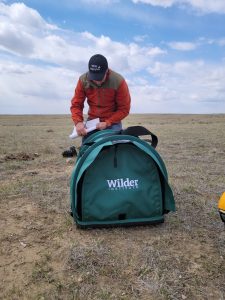20 Endangered Burrowing Owls Have Been Returned To The Wild
May 20, 2022

Earlier this month, Alberta’s prairies warmly welcomed back 20 burrowing owls that were in the care of the Wilder Institute/Calgary Zoo, marking a milestone to bolster Canada’s burrowing owl population. The Wilder Institute/Calgary Zoo is collaborating on a program to recover young owlets from the wild and support them through a head-starting program.
Last-hatched owlets within each wild family of burrowing owls have about a 3% chance of surviving their first year. Head-starting is a conservation tool that brings these youngest owlets into human care. This gives them the chance to grow up in a controlled environment without the threat of predators, extreme weather, competition for food and resources, and other factors.
“Conservation head-starting is just one piece of a very challenging puzzle,” says Graham Dixon-MacCallum, Conservation Research Population Ecologist with the Wilder Institute/Calgary Zoo. “We know that burrowing owls still face threats in their grasslands habitat, but thanks to this important collaborative effort there are more owls in the wild to regain a foothold in the province.”
Giving burrowing owls a fighting chance
Canada’s prairies have been home to burrowing owls for millennia and the species is a charismatic part of the grassland ecosystem. Due to severe habitat loss, climate change, and other changes to their environment, Canada’s burrowing owls have seen a more than 90% decline in their population over the last 40 years and are still facing significant threats. One of the many factors that limit their population from growing is the low survival rate of owlets hatched in the wild.

As migratory birds that travel down to Mexico, they face all the challenges that come along with this long journey, and the journey is becoming more perilous with many of the owls failing to return. To provide support during this difficult stage in their life history, the Wilder Institute/Calgary Zoo head-starts owlets at the zoo’s Wildlife Conservation Centre (WCC).
“We have been lucky enough to care for these owls over the last year, and it’s fantastic to see the progress they have made here at the WCC,” says Colleen Baird, Senior Manager of Animal Care with the Animal Care, Health, & Welfare team at the Wilder Institute/Calgary Zoo. “We want to make sure that the owls are equipped to overcome challenges in the wild. Our team of veterinary, animal care, and conservation research experts work together to ensure the owls are healthy and have excellent body condition.”
A rite of passage into their next stage
Once the owls are ready to go back to the wild, they are moved back to the Canadian grasslands, near where they originally hatched, into secure burrows installed by the team. To ensure that these one-year-old owls can safely mate and lay eggs, a netted enclosure is placed around owl pairs and their burrows, and the new couples are provided with food until eggs are laid. To date, 152 owlets have fledged from head-started owl nests.
The team at the Wilder Institute/Calgary Zoo hopes to see these 20 owls mating and laying eggs this season. Soon, the netted enclosures will be removed, so the owls can take their first official steps back into the wild and contribute to a more vibrant ecosystem.
The Wilder Institute/Calgary Zoo is proud to collaborate with Environment and Climate Change Canada and Alberta Environment and Parks on this project and is thankful to local landowners and Canadian Forces Base Suffield in Alberta for allowing us to work on their land. The success of this critical program would not have been possible without their continued support.

What else is happening in the world of wildlife conservation?
